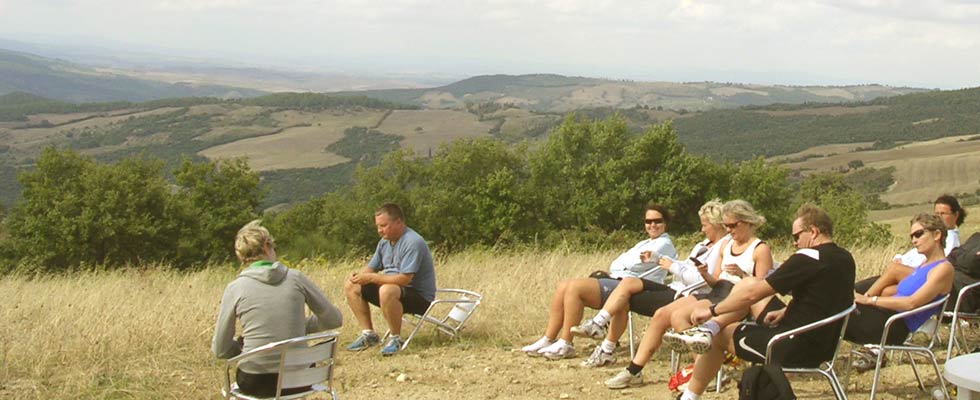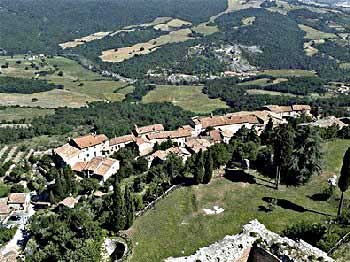
| Weather forecast | Web cam | Weather station | Contact us | Photo Gallery | Links | Search |
| Getting there | Nature | Culture | Epicurean living | Activities | Routes | Our hotel |
Castiglione D'Orcia

(The Castiglion D'Orcia sight)
Castiglione d'Orcia, mentioned since 714, was owned by Aldobrandeschi, and then it became a free commune since 1252; in the fourteenth century it became a Sienese possession and then it was contested by Salimbeni and Siena . The town, with its old paved little roads, is a picturesque centre, above all in Vecchietta Square ( Piazza il Vecchietta ) dedicated to the painter, sculptor and architect Lorenzo di Pietro ( 1412/1480 ), called il Vecchietta.
In the centre of the square, which slopes, there is a beautiful travertine font of 1618. In front of it there is the Town Hall: a fresco of Sienese school representing the Madonna with her Baby and two Saints, coming from Rocca d'Orcia, is kept in it.
The walk inside Castiglione must include also the beautiful Romanesque Church of Santa Maria Maddalena, which has been restored recently. Its façade dates from the thirteenth century, the apse is one century older, and the bell tower is beautiful too.. Its internal is less striking ; but the Church of Santi Stefano and Degna has been the most important religious building of Castiglione, because of the important works kept in it. Its façade dates back to sixteenth century; it kept two important works: The Madonna with her Baby ( later than 1320 ) by Simone Martini and another Madonna with her Baby by Pietro Lorenzetti. These works - and the other - are actually kept by Monuments and Fine Arts Office of Siena.
Once they have been restored, they will form the nucleus of a local Ancient Art Museum . A short slope leads to the Aldobrandesca Fortress, which dominates the town. The walls are still in existence on north side and in the esplanade on its top, a park has been built.
The view that you can admire from there, over Castiglione, Amiata and the Fortress of Tentennano, is beautiful. This striking fortalice; which seems impregnable, is the most exciting sight for the visitor of Castiglione. Rather than approach it by car, it's better to reach it on foot from the town, enjoying the sight of the Fortress encircled by cypresses. Since ninth century it was owned by San Salvatore's Abbey, and then in the half of 1100 it passed on to Tignosi's family, Aldobrandeschi's Vassals.
In 1251 it was transferred to the Commune of Siena, which built another tower in place of the first one; twenty years later it passed on to the Salimbeni, which gave it the present look. The Fortress became in this way the centre of the struggles between this family and the Commune of Siena. The fight ended in 1419 with the surrender of Cocco Salimbeni and his followers.
The fortress has been restored as from 1975 and it can be visited on Saturdays and on Holidays , all year round, and all summer days ( to visit it in different periods, pls. Apply directly to the Town Hall ).
The interior is characterized by mighty ancient massive walls alternated with modern constructions ( staircases, windows, railings ) built as from 1989.
The bare halls and the view that you can admire from the terrace are very striking. From the Fortress of Tentennano you can admire also a beautiful view over Rocca d'Orcia,a village leaning against the rock and built on a steep slope. If you reach it from the top, you will first meet with the Parish of San Simeone, which dates back to 200 and kept important works of art, robbed in the eighties. A flight runs down to the Main Village ( Borgo Maestro ), where you can visit the Church of the Madonna del Palazzo ( used today as a residence ), the Square with the tank dating back to early Middle Ages and restored in 1262, which, in the eighth century, was called the most beautiful vase of Siena's state; the church of The Madonna delle Grazie by Manno and the ruins of the Town Hall. There is also a small Folk Wisdom Museum .
From Rocca d'Orcia a suggestive walk runs down to the exposed gravely river bed of Orcia Valley . You must go down following the asphalt road towards the national road 323, and there turn left following a downhill dirt road ( dead-end sign ), which descends between wood and fields and leads to Molino Farm. You can easily reach it by car. You must descend again following the cart road among the fields, which leads to an ancient mill encircled by vegetation, and to the picturesque course of the Orcia, at the entrance of its defiles. On the right there are the ruins of a travertine bridge, destroyed by a flood in 1929, and the ruins of a footbridge, built in place of it, but collapsed in its turn.
The valley, with its river flowing in a rocky bed, is very suggestive; from there you can sight herons and kestrels and you can go for beautiful walks. Once you crossed the river, on a cement path, you can reach on the left the castle of Ripa d'Orcia and on the right Bagno Vignoni ( it takes little more than half an hour to cover each itinerary ). Taking the path on the left, marked by a sign, which starts from Molino Farm and goes through the left orographic bank of the defiles, you reach another marked path which goes up on the left, in Scarceta and Montelaccio's scrub. If you reach Finocchietti Farm, you can return on the left, to Castiglione d'Orcia, completing in this way an itinerary which takes about three hours. During this walk you can admire the beautiful ilex wood and the panoramas over Ripa d'Orcia, a mighty castle, owned at first by Salimbeni and then by Siena Republic .
Turned in a farm and today in a restaurant, it is one of the most striking fortresses of this region. You can reach it by car leaving Cassia Road near San Quirico and following a beautiful dirt road which skirts the Village of Vignoni .
From the entrance of Ripa d'Orcia's Fortress ( to visit it you must apply to the owners), on the left a path rises in few metres to a spectacular natural balcony on Orcia and Amiata's defiles. Up the town the territory of Castiglione d'Orcia is characterized by wide rises, partly cultivated and partly used as grazing lands; the road to Vivo and Amiata and the aqueduct of Siena run across them.